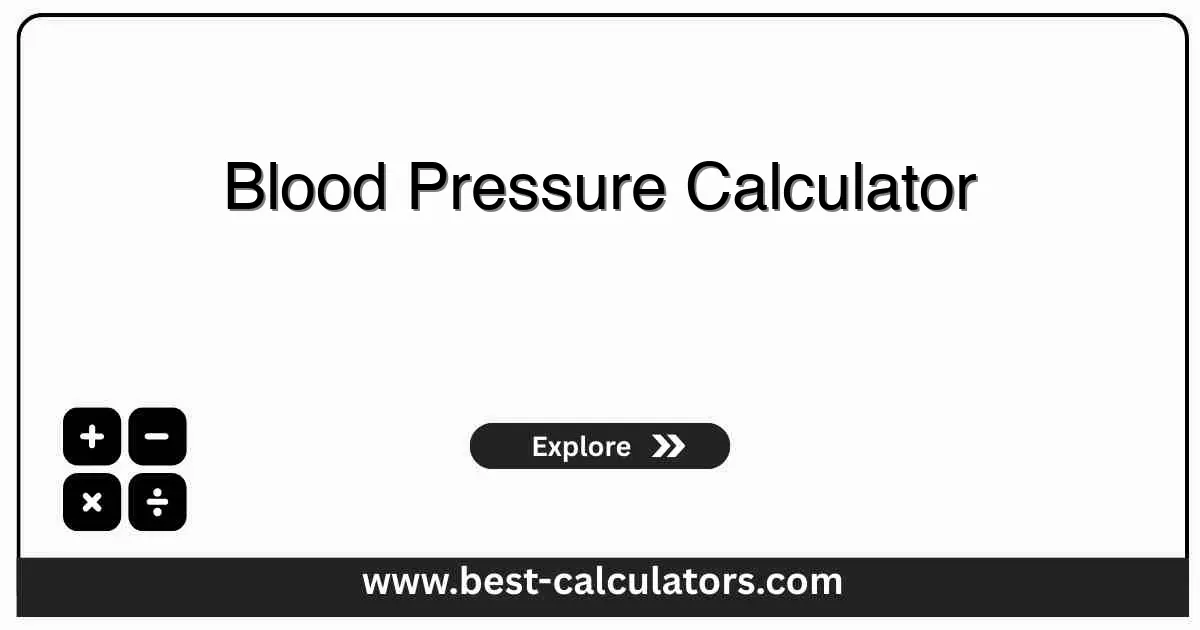Blood Pressure Calculator - Assess Cardiovascular Health
Calculate and interpret your blood pressure readings to assess cardiovascular health risk and receive personalized recommendations based on American Heart Association guidelines
Blood Pressure Calculator
Your Results
Your blood pressure is normal. Maintain healthy lifestyle habits including balanced diet and regular exercise.
What is a Blood Pressure Calculator?
A Blood Pressure Calculator is a free health tool that interprets your blood pressure readings to assess cardiovascular health risk. It analyzes systolic (top number) and diastolic (bottom number) values to determine your BP category according to American Heart Association guidelines.
This calculator helps you:
- Understand BP readings - Know what your numbers mean
- Assess health risk - Identify hypertension early
- Track progress - Monitor changes over time
- Make informed decisions - Discuss results with your doctor
To calculate your overall body health status, check out our BMI Calculator to determine if your weight is in a healthy range for your height.
For understanding your cholesterol levels and heart health, explore our LDL Calculator to assess cardiovascular risk factors beyond blood pressure.
To calculate your resting metabolic rate and energy needs, use our BEE Calculator to understand baseline calorie burn for weight management.
For measuring body composition and health markers, try our Body Fat Percentage Calculator to assess overall cardiovascular health indicators.
To determine your ideal weight for optimal health, check our Ideal Body Weight Calculator to set realistic health goals that support healthy blood pressure.
How the Blood Pressure Calculator Works
The calculator uses American Heart Association (AHA) guidelines to classify blood pressure:
Additional Calculations:
- Pulse Pressure: Systolic - Diastolic (normal: 40-60 mmHg)
- Mean Arterial Pressure (MAP): Diastolic + (Pulse Pressure / 3)
- Risk Assessment: Based on category and additional factors
Note: This calculator provides general guidance. Always consult healthcare professionals for medical advice.
Understanding Blood Pressure Components
Systolic Pressure
Top number measuring pressure when heart contracts and pumps blood. Higher values indicate greater force on artery walls.
Diastolic Pressure
Bottom number measuring pressure when heart relaxes between beats. Reflects arterial resistance.
Pulse Pressure
Difference between systolic and diastolic. Normal range is 40-60 mmHg. Indicates arterial stiffness.
Mean Arterial Pressure
Average pressure in arteries during one cardiac cycle. Normal is 70-100 mmHg. Critical for organ perfusion.
How to Use This Calculator
Measure Blood Pressure
Use a blood pressure monitor at rest
Enter Systolic Value
Input the top number (e.g., 120)
Enter Diastolic Value
Input the bottom number (e.g., 80)
View Analysis
See category, risk level, and recommendations
Benefits of Monitoring Blood Pressure
- • Prevent Heart Disease: High blood pressure is a leading risk factor for heart attacks, strokes, and heart failure.
- • Early Detection: Hypertension often has no symptoms. Regular monitoring catches problems before complications develop.
- • Track Treatment: Monitor effectiveness of lifestyle changes or medications in controlling blood pressure.
- • Reduce Complications: Controlling BP prevents kidney damage, vision loss, and cognitive decline.
- • Improve Longevity: Maintaining healthy blood pressure significantly extends life expectancy and quality of life.
Factors That Affect Blood Pressure
1. Diet and Sodium
High sodium intake raises BP. Limit to 2,300mg daily (1,500mg if hypertensive). Potassium-rich foods help lower BP.
2. Physical Activity
Regular exercise lowers BP by 5-8 mmHg. Aim for 150 minutes of moderate activity weekly for cardiovascular health.
3. Weight and Obesity
Excess weight increases BP. Losing 5-10% of body weight can significantly reduce blood pressure readings.
4. Stress and Sleep
Chronic stress and poor sleep quality elevate BP. Practice stress management and aim for 7-9 hours of quality sleep.
5. Age and Genetics
BP naturally increases with age. Family history of hypertension increases risk. Regular monitoring is essential.

Frequently Asked Questions (FAQ)
Q: What is blood pressure?
A: Blood pressure is the force of blood pushing against artery walls as your heart pumps. It's measured in millimeters of mercury (mmHg) with two numbers: systolic (pressure during heartbeat) over diastolic (pressure between beats). Normal blood pressure is below 120/80 mmHg.
Q: What do systolic and diastolic numbers mean?
A: Systolic (top number) measures pressure when your heart beats and pumps blood. Diastolic (bottom number) measures pressure when your heart rests between beats. Both numbers are important for assessing cardiovascular health.
Q: What is considered high blood pressure?
A: High blood pressure (hypertension) is defined as systolic ≥130 mmHg or diastolic ≥80 mmHg according to American Heart Association guidelines. Stage 1 hypertension is 130-139/80-89 mmHg. Stage 2 is ≥140/90 mmHg.
Q: When should I measure blood pressure?
A: Measure BP at the same time daily, preferably in the morning before medications and evening before dinner. Sit quietly for 5 minutes before measuring. Avoid caffeine, exercise, and smoking 30 minutes prior.
Q: How can I lower my blood pressure naturally?
A: Lower blood pressure naturally through regular exercise, reducing sodium intake, maintaining healthy weight, limiting alcohol, managing stress, eating potassium-rich foods, and getting adequate sleep. Consult your doctor before making major changes.
Q: What is pulse pressure?
A: Pulse pressure is the difference between systolic and diastolic readings. Normal range is 40-60 mmHg. High pulse pressure (>60) may indicate arterial stiffness and increased cardiovascular risk.
Q: How often should I check my blood pressure?
A: Adults should check BP at least once every 2 years if normal. If you have elevated BP or hypertension, check more frequently as recommended by your doctor, often daily for home monitoring.
Q: What is a hypertensive crisis?
A: A hypertensive crisis occurs when BP exceeds 180/120 mmHg. This is a medical emergency requiring immediate attention. Symptoms may include severe headache, chest pain, vision changes, or difficulty breathing. Call 911 immediately.